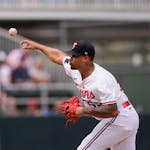 See
more of the story
See
more of the story
The question that couldn't be answered when big-league baseball announced its plan to return to play with a 30-ballpark format was this: What would be the standard for positive coronavirus tests to cause teams to be withheld from competition?
If the paranoia was such that a very low number, say three or fewer, was going to cause a team to be shut down, then it seemed a complete waste of everyone's efforts to plan a 60-game short season across the entirety of the country.
The schedule was announced on July 6, and that fall surge we were being warned about became a summer surge, and now the paranoia level is such that two players for St. Louis were revealed on Friday morning to have tested positive and this nearly prevented four teams from playing later in the day.
The Cardinals were at Milwaukee for the Brewers' home opener; that afternoon game was postponed. The Cardinals' presence at Target Field on Tuesday and Wednesday also caused discussions as to whether the Twins and Cleveland would play Friday night. All of this is impacted by the Marlins having gone quickly from four positive tests to 20.
The major issue for Terry Francona's Cleveland club was that it moved into the visitors clubhouse on Thursday, the one the Cardinals had occupied as recently as Wednesday night. Cleveland decided to play after a team meeting at its Minneapolis hotel at midafternoon.
Only baseball faces the predicament of players fretting over who has come and gone from locker rooms they arrive to occupy. If this 60-game schedule were to be completed, the Twins will occupy nine out-of-town hotels and move in and out of 11 visiting clubhouses — starting with Wrigley Field's for an exhibition on July 22 and winding up back there Sept. 20-22 for a three-game series.
The 22 surviving teams in the NBA are playing inside a bubble near Disney World, using specific locker rooms, isolated in the same hotels. Major League Soccer is conducting its comeback tournament in restricted conditions nearby in Orlando. The WNBA is playing its schedule at the IMG facilities in Bradenton, Fla.
The NHL has 12 teams from the Eastern Conference hunkered down in Toronto and 12 teams from the Western Conference doing the same in Edmonton.
An athlete or staff member tests positive, the individual can be traced immediately and isolated. And if it's an NBA player, not only will you be tossed from the bubble, there's an outside chance Commissioner Adam Silver could send you to Molokai, just for old-time's sake.
So why, you might ask, are baseball teams flying all over this top-10 country of ours to play ballgames, rather than putting together six-team pods in five cities and playing three games a day?
Wipe out the league lines for 10 weeks, send both Chicago teams, St. Louis, Kansas City and the Twins to Milwaukee to play three games a day — starting at 11 a.m. — and may the best three teams advance to Commissioner Ron Manfred's engorged playoffs.
That's fewer clubhouses; more important, hotels dedicated to baseball teams. Yes, you would have to make sure the Astros and the Dodgers didn't wind up in the same pod, and perhaps hotel, but such a system would have given MLB a much better chance to see the finish line.
This way, with travel ball, and sharing hotels with the public (including wedding parties, according to anecdotal evidence), MLB now has had 18 games postponed since Monday.
So that question — why did baseball go this route rather than a "bubble" format?
No matter what logic might be offered, it's this simple: night games.
The regional sports networks, or RSNs as known in the sports business, don't want games at 11 a.m., 3:30 p.m. and 8 p.m. on a Wednesday in Milwaukee. They want three night games played all over, virus be danged.
And there is no sport more beholden to RSNs than baseball.
Much is made of MLB's poor ratings for national telecasts, but add up 15 games on RSNs on cable, satellite or streaming services on a Wednesday night, that's going to be a big number.
As is this: The RSNs paid $1.8 billion (low estimate) to major league teams last season, and that number was due to be $2.1 billion or larger in 2020.
The Twins are now in the low $40 millions from FSN — not large by MLB standards, but enough to make the bottom line work in a non-pandemic season.
What is the influence of those billions from the RSNs? The Twins were outdoors at Met Stadium from 1961 through 1981 and played a total of seven April night games. Cable was a rumor. You could see a Cubs game in the Scoreboard Bar, a 3.2 joint in East Bloomington, and that was about it in the late '70s.
The Twins returned to the great outdoors in 2010. In Year 2, they played a night game on April 9, and again in 2018.
The RSNs say "Jump" and MLB teams say, "How high?" And in 2020, that has been high enough to get hit in the face with a pandemic.
Write to Patrick Reusse by e-mailing sports@startribune.com and including his name in the subject line.







